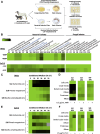Characterizing antimicrobial activity of environmental Streptomyces spp. and oral bacterial and fungal isolates from Canis familiaris and Felis catus
- PMID: 40227049
- PMCID: PMC12108073
- DOI: 10.1128/msphere.00098-25
Characterizing antimicrobial activity of environmental Streptomyces spp. and oral bacterial and fungal isolates from Canis familiaris and Felis catus
Abstract
Antimicrobials are a pillar of modern medicine, yet our limited arsenal of antibiotics and antifungals is currently threatened by widespread drug resistance. Ongoing efforts are focused on developing strategies to identify compounds that enhance the efficacy of current antimicrobials and develop novel, resistance-evasive therapeutic strategies. In this study, we characterized microbial isolates from two distinct environments to identify those that exhibit antimicrobial activity alone and in combination with current antimicrobials: (i) oral isolates from domesticated animals and (ii) environmental Streptomyces spp. First, conditioned media prepared from bacterial and fungal oral isolates that were collected from Canis familiaris and Felis catus were screened for antibacterial and antifungal activity. Three supernatants from bacterial isolates exhibited antifungal activity against the human fungal pathogen Candida albicans in the presence of subinhibitory concentrations of fluconazole, the most widely deployed antifungal. Additionally, two bacterial isolates displayed antibacterial activity against Escherichia coli alone and in combination with the antibacterial ampicillin. Furthermore, 32 environmental isolates of confirmed and predicted Streptomyces spp. were screened for activity against C. albicans and E. coli. Cell-free media harvested from isolates WAC5038 and WAC5287 exhibited antifungal activity against Candida spp., while only the WAC5038-conditioned medium displayed antibacterial activity. Bioactivity-guided fractionation, coupled with UV/Vis absorbance spectra, suggested that the bioactive compound in WAC5287 has a similar absorbance spectrum to the antifungal class of polyenes, while the bioactive component of WAC5038 remains unknown. Overall, this work highlights a strategy to collect and screen environmental isolates for the identification of novel antimicrobials.
Importance: The emergence and spread of antimicrobial resistance presents a global health challenge. As such, researchers are focused on developing pipelines to discover novel antimicrobials. In this study, we screened two distinct collections of microbes for antimicrobial activity. First, we collected bacterial and fungal isolates from the oral cavities of domesticated dogs and cats and identified these isolates using 16S (bacteria) and ITS (fungi) sequencing. Follow-up analyses confirmed that some conditioned media from bacterial isolates had antibacterial activity against Escherichia coli and antifungal activity against Candida albicans both alone and in combination with the current antimicrobial drugs. Additionally, screening 32 predicted or confirmed Streptomyces environmental isolates for antifungal and antibacterial activity identified two isolates with antifungal activity (WAC5038 and WAC5287), with only one isolate demonstrating antibacterial activity (WAC5038). Overall, this study provides a framework to identify and characterize environmental microbes with antimicrobial activity.
Keywords: Candida albicans; Canis familiaris; Escherichia coli; Felis catus; Streptomyces; antimicrobials; drug combinations; resistance.
Conflict of interest statement
L.E.C. is a co-founder and shareholder in Bright Angel Therapeutics, a platform company for the development of novel antifungal therapeutics. L.E.C. is a science advisor for Kapoose Creek, a company that harnesses the therapeutic potential of fungi.
Figures


References
MeSH terms
Substances
Grants and funding
LinkOut - more resources
Full Text Sources
Medical
Research Materials
Miscellaneous
